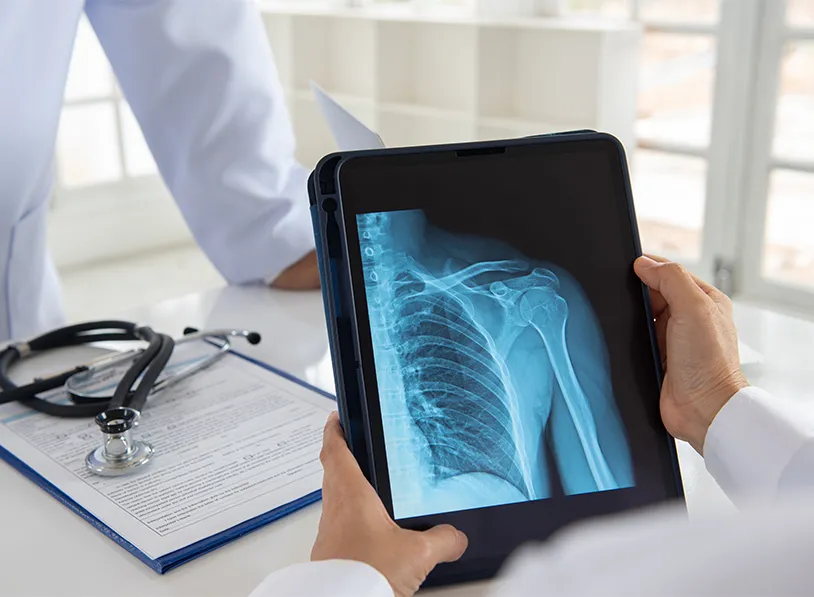Digital X-ray is an advanced form of traditional X-ray technology that uses digital sensors instead of photographic film to capture images of the inside of the body. It produces high-quality, detailed images almost instantly, making it a key tool in modern diagnostics. Digital X-rays have become widely used in healthcare due to their numerous advantages over traditional X-ray systems, such as faster processing, lower radiation exposure, and better image quality.

Digital Image Capture:
- Traditional X-rays use film to capture images, but digital X-rays use a digital sensor to record the X-ray images.
- The sensor captures the X-ray data and converts it into a digital image that can be viewed on a computer screen.
- The resulting images can be stored, enhanced, and transmitted electronically for easier sharing and analysis.
Types of Digital X-ray:
- Computed Radiography (CR): In this system, a special plate captures the X-ray images and later digitizes them using a scanner.
- Direct Digital Radiography (DR): This method uses a digital sensor placed directly into the X-ray machine, which immediately converts the captured X-ray data into digital images. DR is faster and more efficient than CR.
How It Works:
- X-rays are passed through the body, and different tissues absorb the rays at varying levels.
- The sensor (in CR or DR) captures the data from the X-rays as they pass through the body and create an image.
- The image is then sent to a computer where it can be viewed, manipulated, and analyzed by healthcare professionals.
Immediate Image Viewing:
- One of the biggest advantages of digital X-ray over traditional X-ray is the ability to view the images instantly.
- The digital images appear on a computer screen right after the exposure, reducing waiting times for patients and enabling faster diagnosis and treatment decisions.
Benefits of Digital X-ray:
Lower Radiation Exposure:
- Digital X-rays require less radiation compared to traditional X-rays to produce high-quality images. This reduces the overall risk of radiation exposure to the patient.
- The ability to adjust the exposure levels based on the patient’s size and the body part being imaged also helps minimize unnecessary radiation.
Faster Results:
- The images from digital X-rays are available almost immediately after the scan is performed, which helps speed up the diagnostic process.
- This is particularly helpful in emergency situations or for patients who need quick results.
Enhanced Image Quality:
- Digital X-ray images are typically sharper and more detailed than traditional film X-rays.
- The digital images can be zoomed, enhanced, and adjusted for better contrast, helping doctors identify subtle issues more clearly.
Easy Storage and Sharing:
- Digital images can be stored electronically in a patient’s digital medical record, making it easier to retrieve and track over time.
- The images can be shared instantly with specialists or other healthcare facilities, which is especially useful for consultations, second opinions, or referrals.
Environmentally Friendly:
- Unlike traditional X-ray film, which requires chemical processing and physical storage, digital X-rays eliminate the need for film and chemicals, making the process more environmentally friendly.
Space-Saving:
- Digital images do not need to be stored physically, so there is no need for large filing cabinets or storage spaces to keep physical X-ray films.
- This leads to less clutter and easier access to medical records.
Better Patient Comfort:
- Since digital X-ray machines are more efficient and faster, patients spend less time in the imaging process, reducing discomfort and anxiety during the procedure.
Applications of Digital X-ray:
Orthopedic Imaging:
- Digital X-rays are commonly used to detect fractures, joint dislocations, arthritis, and bone diseases. They help doctors assess the condition of bones, muscles, and joints.
Dental Imaging:
- Dentists use digital X-rays to examine teeth, gums, and jawbones for issues like cavities, infections, bone loss, or dental abnormalities. Digital dental X-rays reduce radiation exposure and provide clear images for accurate diagnosis.
Chest X-rays:
- Digital X-rays are often used to evaluate conditions like pneumonia, tuberculosis, heart enlargement, and lung cancer. Chest X-rays provide images of the lungs, heart, and rib cage.
Mammography:
- In breast cancer screening, digital mammography is used to detect abnormal growths or changes in breast tissue. It provides clearer images and helps doctors make more accurate diagnoses.
Abdominal Imaging:
- Digital X-rays can be used to examine the abdomen for conditions such as kidney stones, digestive problems, or abdominal injuries.
Emergency Medicine:
- In emergency situations, digital X-rays provide immediate results, which is crucial for diagnosing injuries or conditions quickly and deciding on the next course of action.
How Digital X-rays Improve Diagnostic Accuracy:
- Image Manipulation:
- Doctors can manipulate digital images (zoom in, enhance contrast, adjust brightness) to get a clearer view of certain areas, helping identify even the smallest abnormalities.
- Comparison:
- Previous digital X-rays can be easily retrieved for comparison with new ones. This helps track the progression of diseases or conditions over time.
- Enhanced Detection:
- Digital X-rays provide high-resolution images, which makes it easier for doctors to detect minute fractures, tumors, or infections that might not be visible in traditional X-ray images.
Limitations of Digital X-rays:
Cost of Equipment:
- Digital X-ray machines can be expensive to purchase and maintain, especially the advanced Direct Digital Radiography (DR) systems. However, the long-term benefits often outweigh the initial costs.
Training Required:
- Healthcare professionals need proper training to effectively use digital X-ray technology and interpret the digital images.
Data Security:
- Since digital X-rays are stored electronically, the data must be protected from hacking or data loss. It is important to ensure the security of the medical data to maintain patient confidentiality.



